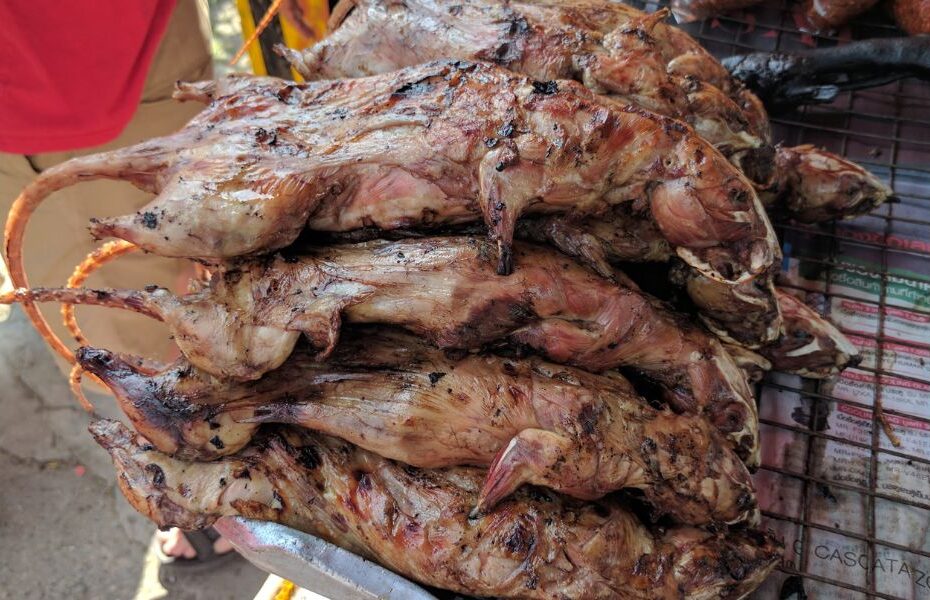[ad_1]
Emergency food shortages are a real possibility.
What will you do when your pantry is empty? You’ll need to improvise. Fortunately, you can hunt down a healthy meal easily enough. The forest is full of food, and one of the best protein sources is the oft-overlooked rat.
You can definitely eat rats in an emergency. In fact, you might even acquire a taste for them. As long as you choose rats that are safe to eat, there’s no reason to worry about the quality of your fare.
The prospect of eating rats can seem daunting at first. However, this is one culinary adventure you don’t want to miss out on.
Is Rat Meat Safe to Eat?

Most people balk at the idea of eating rats because they’re associated with sickness and filth. But while it’s true that rats can carry numerous illnesses, like monkeypox and hantavirus, that doesn’t mean you can’t eat them safely.
Rats are considered somewhat of a delicacy in many Asian, African, and South American countries. Some cultures prize their meat and will catch them in traps or breed them as livestock for food. The practice may have started out of necessity, but it’s a surprisingly sustainable way to get protein.
Dining on the local rat population can help you around the homestead by decreasing the number of critters going after your grain supply. Furthermore, eating pesky rats will save you from sacrificing more valuable livestock, like cows or chickens.
Learn how safe, sustainable rat farms feed citizens in Thailand and get inspiration for your next meal.
It’s important to note that you should never eat a rat’s brain or organs. Bad bacteria like salmonella and leptospira hang around in their intestines and kidneys, while the brain may carry parasites that cause toxoplasmosis.
Additionally, rats can have many other parasites and diseases that affect the brain, spine, nervous system, and other organs systemically.
Some parasites and bacteria might die off when the rat is cooked, but some of them won’t.
You never really know what diseases a rat has without lab testing, so you can’t diagnose them with anything specific. Is eating rat brains really worth the risk? I say no.
Staying safe is paramount to your survival in an emergency, so leave the organs for the birds.
How to Choose Edible Rats
Although it may be tempting, you can’t start eating rats at random. You have to choose rats that are safe for consumption.
To determine if a rat is safe to eat, examine its diet and living conditions. City rats eat trash and often nest in sewers or other unsanitary places. They live a high-risk lifestyle that encourages disease, so eating sewer rats is generally a bad idea.
Country rats are a different story. They nest in cleaner places and primarily eat grains, forest fruits, and edible plants.
Since their diet is relatively clean, they’ll be much safer to eat. But even country rats can have parasites, ticks, fleas, and other pests nesting in their fur. Parasites and pests transmit vector-borne illnesses and can potentially make you sick.
To avoid any disease-bearing additions to your dinner, try to limit your rat consumption to the wintertime. Insects are not as active in the cold season, so there’s a smaller likelihood of contamination and subsequent illness.
If you must eat rats during the warmer months, study the animals carefully. If a rat appears sick, don’t eat it.
How to Reduce the Risks of Eating Rats
Eating any wild game comes with certain risks. You can decrease the chance of disease by following a few sage words of advice.
Tips on how to eat rats safely:
- Avoid touching the rat directly. Instead, wear gloves when catching, killing, and butchering rodents.
- Wash your hands and equipment thoroughly with soap and water before and after butchering.
- When butchering, eviscerate the rat and completely remove its head, brain, spinal cord, and all its organs.
- Once you dress a rat carcass, rinse it in water before cooking it.
- If you catch and store live rats, avoid touching their feces and keep their environment clean until it’s time to harvest them.
- Cook rat meat to at least 165°F to kill off harmful bacteria.
What Does Rat Meat Taste Like?
The flavor of rat meat depends a lot on how you prepare it. For the most part, even an inexperienced chef can barbecue a rat over a fire. Campfire rat meat is comparable to rabbit, guinea pig, or squirrel meat. It has a distinctive, pungent smell and an undercurrent of gamey flavor.
While rat is pretty lean, it has fat stores that provide a bit of flavor. This is especially true for wild rats, which tend to eat a richer and more varied diet. When prepared exceptionally well, rat meat will have only a hint of gamey taste. It leans more toward the flavor of fowl than that of other wild rodents.
Discover the delightfully simple fire-grilled rat, a mild meat with a surprisingly gentle flavor.
Once skinned and prepared, rats are almost indistinguishable from other small game. I always say that the texture is like the dark meat of a chicken, but the consistency is a bit drier. The meat is utterly delicious, so don’t let your rat-based bias stop you from trying something new.
Is it Legal to Hunt and Eat Rats?
Most state governments classify rats as nuisance wildlife, which you can kill anytime during any season. Nuisance wildlife cause problems by invading homes, orchards, and gardens to steal food. They can also nest in barns and houses, destroying electrical wiring and insulation.
If you want to hunt and eat rats, be sure to do your research. What type of rats live near you? Determine their species’ legal classification in your state. Many rats, including the common field rat, are not protected under wildlife management laws. If that’s the case, it’s open season on your unfortunate rat population.
How to Hunt Rats
Most rats aren’t “hunted” in the traditional sense. You wouldn’t want to shoot one, as there wouldn’t be any rat left to dine on. Instead, we catch them using traps.
If you’re going to eat the rats, it’s better to use a live trap that does not kill the animal instantly. If your rat dies in the trap while you’re away, it will begin to decompose and attract bacteria immediately.
While killing the rat yourself might be an unsavory idea, it’s the lesser of two evils. If you’re going this route, you must learn how to dispatch rats humanely.
Cervical dislocation is the fastest and easiest method. Holding it against the ground, you’ll grip the rat’s head firmly with one hand and its body in the other. In a single motion, pull hard and very quickly on the rat’s hindquarters to separate the spine from the neck. It should die instantly.
So, which trap is best for beginners?
I recommend a bucket trap. One like the Tulardom Bucket Trap will be the easiest to start with because it’s simple to set up.
All you need is a bucket and some bait. You lure the rat out onto a plank with the bait, and its weight tips it over into a bucket. You can catch many rodents with a single five-gallon bucket, and they’ll all stay alive until you come to harvest them.
Alternatively, you can make your own bucket trap. You can use other makeshift small game traps if you don’t have a bucket. Makeshift traps differ in utility and function, so it’s better to familiarize yourself with a few different kinds.
That way, you can use nearby materials to make traps and eat well no matter where you are. Knowing how to build these traps can save your life in an emergency.
Learn how to make your own traps and snares to use in a survival situation.
Is Rat Meat Good for You?
Rat meat has an exceptional nutritional breakdown. Unfortunately, you can’t take full advantage of it because you cannot eat the brain and internal organs. While these parts do contain many vitamins and nutrients, the risk of contracting disease far outweighs any potential benefits from rat organ meat.
Even without the organs, rats pack a mean nutritional punch. The average adult rat weighs between 300–500 grams and yields around four ounces of edible meat.
You can get anywhere from 200–400 calories per rat harvested, most of which come from protein. You’ll get around 20–40 grams of protein per rat and a healthy dose of omega-3 fats.
Like most meat, a rat won’t provide you with fast-acting energy from carbohydrates. However, it is an excellent source of Vitamin A, Vitamin E, iron, and phosphorus. You may have to harvest several rats if you’re trying to feed a family, but even one will do as a snack.
How to Prepare Rat Meat
You can prepare rat meat any way you like, though some methods may be tastier or healthier than others.
The most important thing is to butcher the rat properly to reduce your risk of disease.
Some people like to leave the rat fur on and char it over a fire. Burning the fur can make skinning the rat easier and kill bacteria.
Depending on your situation, it may be better to remove the fur and skin before grilling the rat. You can default to your regular method for butchering rodents like squirrels or rabbits.
Using gloves, you’ll skin the rat and eviscerate it. Remove the head, spine, and all the internal organs before washing it thoroughly. Once you’ve got that nice pink carcass in hand, the sky’s the limit.
Check out this delicious recipe for fried field rats to learn how different cultures cook their rodents.
If you aren’t sure where to start, take a lesson from the pros. There are dozens of cultures that eat rat meat, each one preparing it in different ways.
Indigenous tribes of the Andes and Australian aboriginals like to barbecue it, while the Vietnamese and some North African tribes deep-fry it in oil. Rat meat can even be canned and stored for later, providing a sustainable meat source throughout the winter.
You can make rat jerky by slow-smoking it and drying it. Stewing rats with acidic tomatoes offsets the gamey taste and softens the fibrous texture of the meat.
If you’re in a survival situation, you will likely be cooking your rat over a fire. In this case, you can simply dress and skewer it. Make sure to turn it a few times so it cooks evenly. When the temperature reaches at least 165 °F, you’ve met the USDA standard for food safety.
Congratulations! It’s time to chow.
Ready to get your rat on? These nutrient-rich rodents are tasty and plentiful. Whether you like them barbecued, roasted, fried, or stewed, rat meat is the perfect addition to any emergency meal plan.
[ad_2]
Source link

